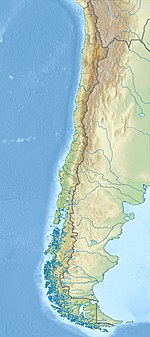Coquimbo Formation
| Coquimbo Formation Stratigraphic range: Miocene–Mid Pleistocene ~ | |
|---|---|
| Type | Geological formation |
| Underlies | Alluvium |
| Overlies | |
| Thickness | 63 m (207 ft) |
| Lithology | |
| Primary | Conglomerate, sandstone, siltstone, shale and coquina |
| Other | Clay lenses, terra rossa |
| Location | |
| Coordinates | 30°20′21″S 71°32′03″W / 30.33917°S 71.53417°WCoordinates: 30°20′21″S 71°32′03″W / 30.33917°S 71.53417°W |
| Approximate paleocoordinates | 30°06′S 70°18′W / 30.1°S 70.3°W |
| Region | Coquimbo Region |
| Country | |
| Extent | Tongoy Bay |
| Type section | |
| Named for | Coquimbo |
 Coquimbo Formation (Chile) | |
Coquimbo Formation (Spanish: Formación Coquimbo) is a Miocene to Middle Pleistocene sedimentary formation located in Coquimbo Region in Norte Chico, Chile. The lowermost unit belongs to the lower Miocene, with the third-deepest unit dated at 11.9 ± 1.0 Ma. The uppermost unit of the formation is estimated at 1.2 Ma. In the area of Tongoy, the Coquimbo Formation was deposited in an ancient bay that was formed in a graben or half-graben, with a normal fault dipping east. Sea level changes during the Holocene have caused erosion to cut several marine terraces into the formation.[1]
Fossil content[]
The following fossils have been found in the formation:
| SALMA | Group | Fossils | Notes |
|---|---|---|---|
| Montehermosan | Mammals | , , , ?Squalodon sp., Balaenidae indet. | |
| Birds | cf. Palaeospheniscus sp., Spheniscus sp., Diomedeidae indet., Spheniscidae indet. | ||
| Fish | Carcharodon carcharias | ||
| Mayoan | Cosmopolitodus hastalis |
See also[]
References[]
- ^ Le Roux, J.P.; Olivares, Danisa M.; Nielsen, Sven N.; Smith, Norman D.; Middleton, Heather; Fenner, Juliane; Ishman, Scott E. (2006). "Bay sedimentation as controlled by regional crustal behaviour, local tectonics and eustatic sea-level changes: Coquimbo Formation (Miocene–Pliocene), Bay of Tongoy, central Chile" (PDF). Sedimentary Geology. 184 (1–2): 133–153. Bibcode:2006SedG..184..133L. doi:10.1016/j.sedgeo.2005.09.023. Retrieved 11 April 2016.
- ^ Coquimbo at Fossilworks.org
- ^ Bahia de Guayacan at Fossilworks.org
- ^ Bahia Herradura at Fossilworks.org
- ^ La Cantera at Fossilworks.org
- ^ Chanaral de Aceituno at Fossilworks.org
- ^ Tongoy area Unit 11 at Fossilworks.org
- ^ Tongoy area Unit 4 at Fossilworks.org
Further reading[]
- C. Acosta Hospitaleche, J. Canto, and C. P. Tambussi. 2006. Pingüinos (Aves, Spheniscidae) en Coquimbo (Mioceno Medio-Plioceno Tardio), Chile y su vinculación con las corrientes oceánicas. Revista Española de Paleontología 21(1):115-122
- ; ; ; ; ; , and . 2015. Late Neogene Elasmobranch fauna from the Coquimbo Formation, Chile. 18. 261–272. Accessed 2017-08-15.
Categories:
- Geologic formations of Chile
- Miocene Series of South America
- Pliocene Series of South America
- Neogene Chile
- Pleistocene Chile
- Mayoan
- Montehermosan
- Conglomerate formations
- Sandstone formations
- Siltstone formations
- Tidal deposits
- Paleontology in Chile
- Geology of Coquimbo Region
